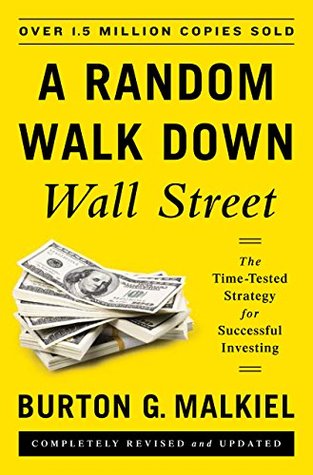More on this book
Community
Kindle Notes & Highlights
as investment banking revenues became a major source of profits for the major brokerage firms, research analysts were increasingly paid to be bullish rather than accurate.
mutual-fund portfolios have not outperformed randomly selected groups of stocks.
Just as past earnings growth cannot predict future earnings, neither can past fund performance predict future results.
the nature of an average that some investors will beat it.
efficient-market hypothesis split into two. The “semi-strong” form says that no public information will help the analyst select undervalued securities.
“strong” form says that absolutely nothing that is known or even knowable about a company will benefit the fundamental analyst.
The “narrow” (weak) form of the EMH says that technical analysis—looking at past stock prices—cannot help investors. Prices move from period to period very much like a random walk. The “broad” (semi-strong and strong) forms state that fundamental analysis is not helpful either.
The market is so efficient—prices move so quickly when information arises—that no one can buy or sell fast enough to benefit.
technology has dramatically improved the efficiency of trading, reducing transaction costs and increasing liquidity for all investors. It has also helped ensure that market-moving news is reflected in stock prices as rapidly as possible.
efficient-market hypothesis explains why the random walk is possible. It holds that the stock market is so good at adjusting to new information that no one can predict its future course in a superior manner.
risk alone, determines the degree to which returns will be above or below average.
financial risk has generally been defined as the variance or standard deviation of returns.
distribution of returns is symmetric—that is, as long as the chances of extraordinary gain are roughly the same as the probabilities for disappointing returns and losses—a dispersion or variance measure will suffice as a risk measure. The greater the dispersion or variance, the greater the possibilities for disappointment.
historical returns from individual securities has not usually been symmetric, the returns from well-diversified portfolios of stocks are at least roughly symmetric.
Portfolio theory
least risk possible, consistent with the return they seek.
portfolio as a whole could be less risky than the individual stocks
perfect negative relationship between the companies’ fortunes (one always does well when the other does poorly), diversification can totally eliminate risk.
diversification will not help much if there is a high covariance (high correlation) between the returns of the two companies.
fifty is also the golden number for global-minded investors.
paradoxical result of this analysis is that overall portfolio risk is reduced by the addition of a small amount of riskier foreign securities.
Globalization led to an increase in the correlation coefficients between the U.S. and foreign markets
Bonds (and bond-like securities to be covered in Part Four) have proved their worth as an effective diversifier.
systematic risk and that this arises from the basic variability of stock prices
unsystematic risk and results from factors peculiar to that particular company
beta is the numerical description of systematic risk.
comparison between the movements of an individual stock (or portfolio) and the movements of the market as a whole.
the unsystematic risk is substantially eliminated and our portfolio (with a beta of 1) will tend to move up and down essentially in tandem with the market.
adjust to offer higher returns where more risk is perceived,
total risk that investors will get paid for bearing is systematic risk, the risk that diversification cannot help.
the total risk of each individual security is irrelevant. It is only the systematic component that counts
Because stocks can be combined in portfolios to eliminate specific risk, only the undiversifiable or systematic risk will command a risk premium. Investors will not get paid for bearing risks that can be diversified away.
premium you get on any stock or portfolio increases directly with the beta value you assume.
beta for any security is essentially the same thing as the covariance between that security and the market index
any particular stock index is an imperfect representative of the general market. Hence, beta may fail to capture a number of important systematic elements of risk.
the laborer in a Ford plant will find that holding Ford common stock is particularly risky, because job layoffs and poor returns from Ford stock are likely to occur at the same time.
in addition to the traditional beta measure of risk, a number of systematic risk variables, such as sensitivity to changes in national income, in interest rates, and in the rate of inflation. Of course, the APT measures of risk
THE FAMA-FRENCH THREE-FACTOR MODEL
beta
the size of the company
the relationship of its market price to its book value.
momentum factor could be added to capture the tendency for rising or falling stocks to continue moving in the same direction. In addition, a liquidity factor could be added to reflect the fact that investors need to be paid a return premium to induce them to hold
the irrational trades of investors tend to be correlated.
four factors that create irrational market behavior: overconfidence, biased judgments, herd mentality, and loss aversion.
“arbitrage” is used to describe the buying of stocks that appear “undervalued” and the selling of those that have gotten “too high.” In so doing, hardworking arbitrageurs can smooth out irrational fluctuations in stock prices and create an efficiently priced market.
overestimate their own knowledge, underestimate the risks involved, and exaggerate their ability to control events.
people tend to put larger stakes on their predictions than are justified.
hindsight bias. Such errors are sustained by having a selective memory of success.
People are prone to attribute any good outcome to their own abilities. They tend to rationalize bad outcomes as resulting from unusual external events.
behavioralists believe that overconfidence in the ability to predict the future growth of companies leads to a general tendency for so-called growth stocks to be overvalued.


